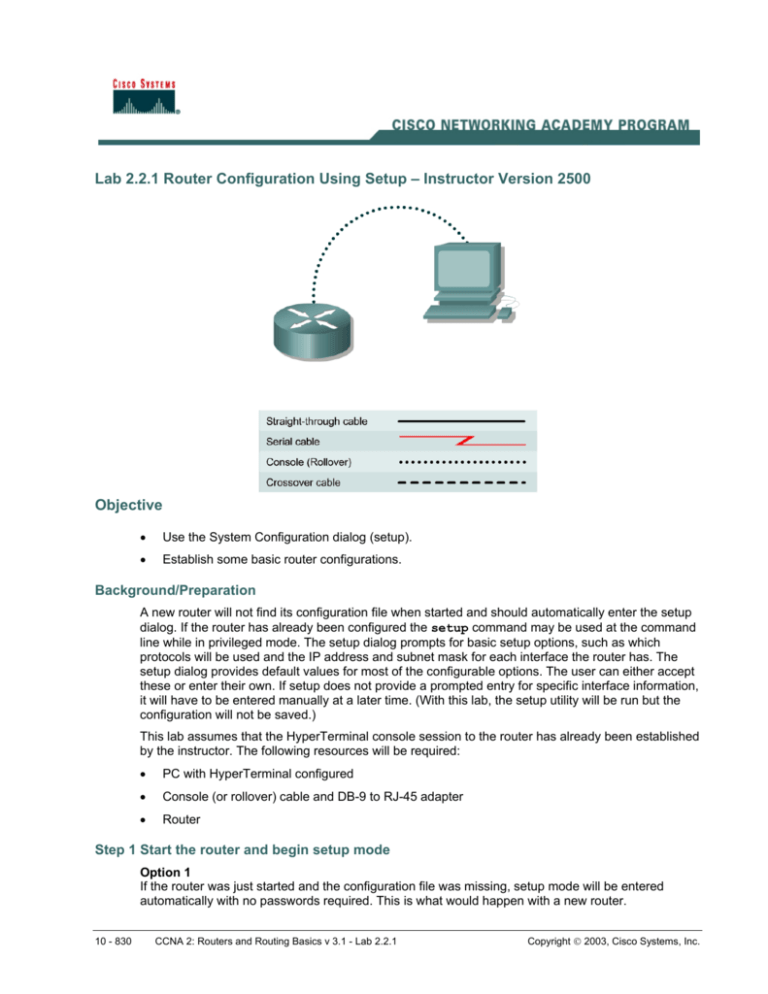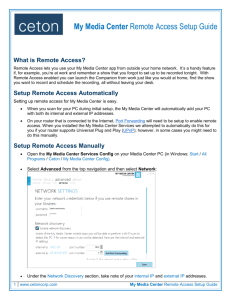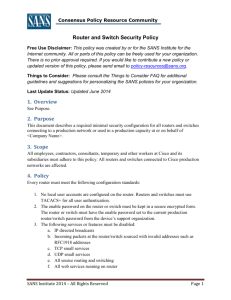Lab 2.2.1 Router Configuration Using Setup – Instructor Version
advertisement

Lab 2.2.1 Router Configuration Using Setup – Instructor Version 2500 Objective • Use the System Configuration dialog (setup). • Establish some basic router configurations. Background/Preparation A new router will not find its configuration file when started and should automatically enter the setup dialog. If the router has already been configured the setup command may be used at the command line while in privileged mode. The setup dialog prompts for basic setup options, such as which protocols will be used and the IP address and subnet mask for each interface the router has. The setup dialog provides default values for most of the configurable options. The user can either accept these or enter their own. If setup does not provide a prompted entry for specific interface information, it will have to be entered manually at a later time. (With this lab, the setup utility will be run but the configuration will not be saved.) This lab assumes that the HyperTerminal console session to the router has already been established by the instructor. The following resources will be required: • PC with HyperTerminal configured • Console (or rollover) cable and DB-9 to RJ-45 adapter • Router Step 1 Start the router and begin setup mode Option 1 If the router was just started and the configuration file was missing, setup mode will be entered automatically with no passwords required. This is what would happen with a new router. 10 - 830 CCNA 2: Routers and Routing Basics v 3.1 - Lab 2.2.1 Copyright 2003, Cisco Systems, Inc. Option 2 If the router was previously configured and it is desired to see and change existing settings, it will be necessary to login and provide a password of cisco. Type enable at the command prompt to enter privileged mode and enter the password class. Enter setup at the router prompt to start the system configuration dialog. Option 3 If the router was previously configured, it is possible to simulate a new router by removing the configuration file from NVRAM using the erase startup-config command in privileged mode. Use the reload command to restart the router and enter setup mode. Note: The order of the messages displayed during Setup may vary depending on the Cisco IOS software release and feature set on the router. Therefore the following prompts may not exactly reflect the messages on the screen. Step 2 Continue with the setup dialog a. The router prompts, "Continue with configuration dialog?“ Enter yes to continue with the setup dialog. b. The router prompts afterwards, "Would you like to enter basic management setup?" Enter no to continue. c. What is the importance of words in the square brackets? This is the default answer if the Enter key is pressed. Step 3 Show the current interface summary a. The router asks, “First, would you like to see the current interface summary?” or "Would you like to enter basic management setup?" Press the Enter key or type yes to accept the default answers. b. Fill in the following table with the information displayed. Various answers will be displayed dependent upon the routers used. Interface IP-Address OK Method Status Protocol Step 4 Configure global parameters a. Configure the router using the default settings for any questions the router asks if it has already been configured. The router may be named at this time if it has not been already. Make sure that cisco is entered as the enable secret password. Next, the basic management setup prompt will appear. This allows parameters such as router name, privileged level passwords, and virtual terminal password to be entered. Answer the prompts as follows: Router name = Central, enable secret password = cisco, enable password = class, virtual password = cisco. b. Next will be the prompt to enter various parameters including SNMP settings, and routed and routing protocol settings. Answer no to these prompts, except for the "Configure IP?" prompt. 11 - 830 CCNA 2: Routers and Routing Basics v 3.1 - Lab 2.2.1 Copyright 2003, Cisco Systems, Inc. Step 5 Configure interface parameters a. From this point on, the prompts vary depending on the available router interfaces. Complete the setup steps as appropriate. Step 6 Configuration command script a. The router displays the configuration command script that was created and then asks if this configuration is to be saved. b. When asked whether or not to use the configuration, answer no. c. If the answer was yes, when asked whether or not to use the configuration, where would this information be saved? NVRAM Note: Remember that setup does not provide for entry of key information such as clock rate for DCE interfaces. These must be entered later. Upon completion of the previous steps, logoff by typing exit. Turn the router off. 12 - 830 CCNA 2: Routers and Routing Basics v 3.1 - Lab 2.2.1 Copyright 2003, Cisco Systems, Inc. Lab 2.2.1 Router Configuration Using Setup – Instructor Version 2600 Objective • Use the System Configuration dialog (setup). • Establish some basic router configurations. Background/Preparation A new router will not find its configuration file when started and should automatically enter the setup dialog. If the router has already been configured the setup command may be used at the command line while in privileged mode. The setup dialog prompts for basic setup options, such as which protocols will be used and the IP address and subnet mask for each interface the router has. The setup dialog provides default values for most of the configurable options. The user can either accept these or enter their own. If setup does not provide a prompted entry for specific interface information, it will have to be entered manually at a later time. (With this lab, the setup utility will be run but the configuration will not be saved.) This lab assumes that the HyperTerminal console session to the router has already been established by the instructor. The following resources will be required: • PC with HyperTerminal configured • Console (rollover) cable and DB-9 to RJ-45 adapter • Router Step 1 Start the router and begin setup mode Option 1 If the router was just started and the configuration file was missing, setup mode will be entered automatically with no passwords required. This is what would happen with a new router. 424 - 830 CCNA 2: Routers and Routing Basics v 3.1 - Lab 2.2.1 Copyright 2003, Cisco Systems, Inc. Option 2 If the router was previously configured and it is desired to see and change existing settings, it will be necessary to login and provide a password of cisco. Type enable at the command prompt to enter privileged mode and enter the password class. Enter setup at the router prompt to start the system configuration dialog. Option 3 If the router was previously configured, it is possible to simulate a new router by removing the configuration file from NVRAM using the erase startup-config command in privileged mode. Use the reload command to restart the router and enter setup mode. Note: The order of the messages displayed during Setup may vary depending on the Cisco IOS software release and feature set on the router. Therefore the following prompts may not exactly reflect the messages on the screen. Step 2 Continue with the setup dialog a. The router prompts, "Continue with configuration dialog?“ Enter yes to continue with the setup dialog. b. The router prompts afterwards, "Would you like to enter basic management setup?" Enter no to continue. c. What is the importance of words in the square brackets? This is the default answer if the Enter key is pressed. Step 3 Show the current interface summary a. The router asks, “First, would you like to see the current interface summary?” or "Would you like to enter basic management setup?" Press the Enter key or type yes to accept the default answers. b. Fill in the following table with the information displayed. Various answers will be displayed dependent upon the routers used. Interface IP-Address OK Method Status Protocol Step 4 Configure global parameters a. Configure the router using the default settings for any questions the router asks if it has already been configured. The router may be named at this time if it has not been already. Make sure that cisco is entered as the enable secret password. Next, the basic management setup prompt will appear. This allows parameters such as router name, privileged level passwords, and virtual terminal password to be entered. Answer the prompts as follows: Router name = Central, enable secret password = cisco, enable password = class, virtual password = cisco. b. Next will be the prompt to enter various parameters including SNMP settings, and routed and routing protocol settings. Answer no to these prompts, except for the "Configure IP?" prompt. 425 - 830 CCNA 2: Routers and Routing Basics v 3.1 - Lab 2.2.1 Copyright 2003, Cisco Systems, Inc. Step 5 Configure interface parameters a. From this point on, the prompts vary depending on the available router interfaces. Complete the setup steps as appropriate. Step 6 Configuration command script a. The router displays the configuration command script that was created and then asks if this configuration is to be saved. b. When asked whether or not to use the configuration, answer no. c. If the answer was yes, when asked whether or not to use the configuration, where would this information be saved? NVRAM Note: Remember that setup does not provide for entry of key information such as clock rate for DCE interfaces. These must be entered later. Upon completion of the previous steps, logoff by typing exit. Turn the router off. 426 - 830 CCNA 2: Routers and Routing Basics v 3.1 - Lab 2.2.1 Copyright 2003, Cisco Systems, Inc.









